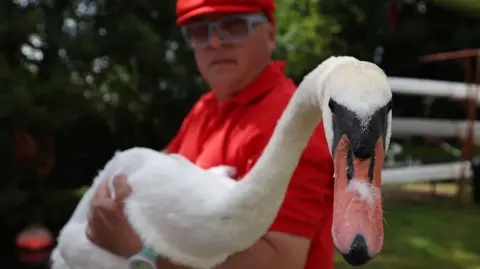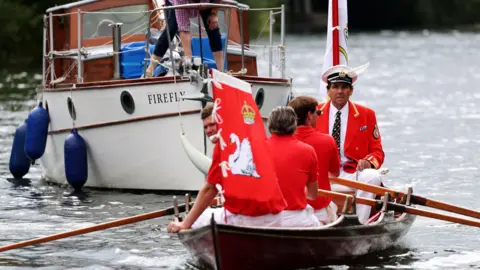 EPA
EPAThe annual royal census of swans on the River Thames, known as “swan upping”, has found numbers down again.
There were only 86 young swans found in a five-day search of the river between London and Oxfordshire, a 45% decline in two years.
The King’s Swan Marker, David Barber, blamed catapults and air-gun shootings, as well as the ongoing impact of avian flu.
“I can’t say that it was a good year, unfortunately the numbers were lower than last year,” said Mr Barber.
 EPA
EPAThe traditional counting of swans on the Thames is an annual summer spectacle, with brightly dressed teams of rowers going up the river, under the stewardship of the King’s Swan Marker, who wears a swan’s feather in his cap.
This medieval ceremony now has a modern conservation purpose in monitoring the swan population, counting, weighing and measuring swans before releasing them back into the water.
There had been hopes that this year would see a recovery after last year’s count found swan numbers badly hit by avian flu.
However, the numbers have fallen again, making the traditional image of swans on the Thames a rarer sight, with the lowest numbers since 2016.
Mr Barber said there could still be an impact from avian flu in reducing breeding pairs, and some nests had been washed away by high flood waters in the spring.
The King’s Swan Marker also blamed “catapult and air-gun shootings, which definitely has not helped the situation”.
“The poor swan has rather a lot to contend with these days.”
 Reuters
ReutersMr Barber says the swan upping event is “unique” and every July it attracts people from all over the world.
However, he wants to use the attention to improve protection for swans, particularly in terms of educating people about not harming them.
This year’s swan upping trip up the river had the involvement of schools along the route, in an attempt to spread the message about protecting wildlife.
In previous years the quirky event, watched by onlookers along the river, had been used to tell fishermen to be careful about not leaving fishing tackle or hooks that could hurt swans.
Swan upping, which dates back to the Middle Ages, began as a way of counting the birds which were valuable property – with any unmarked mute swans being the property of the Crown.





